I noticed that the input impedance of an op Amp is extremely high. Why is that so?
-
4It's part of the definition of what a opamp is. The ideal opamp has infinite input impedance. – Olin Lathrop Jun 13 '12 at 15:59
4 Answers
It's one of the rules. For an ideal opamp goes that
- input impedance is infinite (input current is zero)
- gain is infinite
- output impedance is zero
- input offset voltage is zero
If these requirements aren't met several basic opamp circuits wouldn't work. Take for instance the inverting amplifier.

The transfer function is
\$ \mathrm{V_{OUT} = - \dfrac{R_f}{R_{IN}} \cdot V_{IN}} \$
as derived in this answer. The proof relies on the infinite input impedance, but you can't explain the transfer function based on both inputs equal, because that's not a property of the opamp! So-called proofs that start from the fact that the inverting input is at ground are invalid.
Note that FET input opamps do better than their BJT input counterparts. The former will have pA input current, whereas for the latter this may be several \$\mu\$A.
Further reading:
Opamps for everyone
-
If the op amp and all other circuits were ideal in all regards except for input impedance, the op amp's input impedance would not affect the behavior of that circuit unless it has a zero-ESR capacitive component; if nothing else would ever cause any potential to appear across the op amp's inputs, it wouldn't matter whether there existed any means for current to flow between them. Of course, if the op amp or other components are non-ideal, adding input impedance may affect the way those non-ideal components behave. – supercat Jun 13 '12 at 15:55
-
@supercat - suppose both resistors 1k, input impedance to -12V: 1k. Vin +1V. Then instead of Vout = -1V you'd get Vout = +11V. Pull KCL from the library and do the calculation. – stevenvh Jun 13 '12 at 16:02
-
Input impedance to a non-ground voltage potential would be a problem, of course. If the non-inverting input doesn't budge from ground, however, inverting-input impedance to either ground or to the non-inverting input would be non-factors in an otherwise-ideal op amp used with ideal components. – supercat Jun 13 '12 at 16:05
-
A number of practical op amp designs have historically had a relatively low and non-linear impedance between the two inputs, and some still do (some, for example, specify that current may flow between the inputs if the potential between them exceeds a fraction of a volt). Whether or not this is a problem will depend upon how the various non-ideal characteristics of the op amp and surrounding components interact. – supercat Jun 13 '12 at 16:08
-
@supercat - But "ground" doesn't mean anything to an opamp if it's fed from +/-12V. Look at the schematic of any opamp, you won't find a net that's ground. Impedance is always to either of the supplies. You would be right that an impedance to ground, and the pin grounded, wouldn't see any current, but that's not the case. – stevenvh Jun 13 '12 at 16:10
-
Impedance between the inputs of an op amp is sometimes specified, since it is relevant in some circuits but not others. Further, with regard to the supply, what matters is unbalanced current rather than impedance. If your op amp had a 1mA positive current source on its inverting input, the input impedance would be infinite, but the circuit wouldn't work. Conversely, if it had a 1pF cap in series with a 1microohm resistor from a supply rail to the inverting input, the resistive impedance of that input would only be 1 microohm, and there'd be a power-on glitch, but... – supercat Jun 13 '12 at 16:23
-
...the effect of that glitch would decay by 360dB per second; once the glitch decayed, assuming the power supply was precisely stable, that impedance would have no other effect on circuit operation (of course, the high-frequency power-supply rejection ratio would be terrible, but if one assumes everything is ideal other than the op amp input impedance, that won't matter). – supercat Jun 13 '12 at 16:25
A very high input impedance gets us closer to an ideal op-amp. The characteristics of an ideal op-amp are:
- Infinite bandwidth
- Infinite gain
- Infinite input resistance
The ideal op-amp exists because using it as a basis for analysis provides several worthwhile shortcuts that simplify the math involved. The infinite input resistance is important because it ensures that no current goes into the op-amp. This simplifies the analysis of feedback op-amp circuits.
Also, high input impedance is desirable in most circumstances. It allows a signal with very weak drive to be correctly read by the op-amp and amplified. If it had low input impedance the op-amp would draw down the voltage of the weak signal and not properly amplify it.
- 8,669
- 20
- 29
The higher the input impedance, the less likely that the opamp itself will effect the input signal.
Think of input and output impedance as a voltage divider made from two resistors. The input impedance of the opamp is the lower resistor, while the output impedance of whatever device is feeding the opamp is the high resistor.
The best case is when the output impedance is super low while the input impedance is super high. In this case the voltage divider is barely bringing the voltage down.
Worst case is when the output impedance is super high and the input impedance is super low. Then the signal might be divided down to 1/100th of the original voltage, or worse!
So, it's better if the input to the opamp has the highest impedance possible.
There are cases where you might want a lower input impedance. But in these cases you usually just put a load resistor on the input signal and don't rely on the opamp to do that for you. Your load resistor (or terminating resistor, or whatever) will have higher tolerances than what the opamp will give you normally.
The answers are all good, but there is a more basic and more important concept behind that, in part explained by David.
The Op-amp, at least the most common type of op-amp, is a voltage-input, voltage-output component: it means that it takes a voltage as input, does some operation and spits out another voltage.
Reading a voltage requires attaching an instrument to the voltage source, as you would do with a voltmeter: this instrument has to be put in parallel (has to read the same voltage) with the source itself, and will see a current on it that depends on the input resistance of the instrument itself, in this case the op-amp. The current will also flow on the output resistance of the source, as shown in the picture:

The current on the resistor will cause a drop on the input voltage to the op-amp, that won't be anymore equal to the source: we don't want that.
So if the op-amp has an infinite resistance, the current on the input will be zero and the read voltage will be Vg, as desired. Of course that's an ideal condition, but the higher the better.
- 13,481
- 4
- 40
- 80
-
I think this is a valid answer, if there is something wrong please point it – clabacchio Jun 14 '12 at 07:01
-
Downvoter had posted a comment, but for some reason deleted it. I don't recall his motive. – stevenvh Jun 14 '12 at 16:59